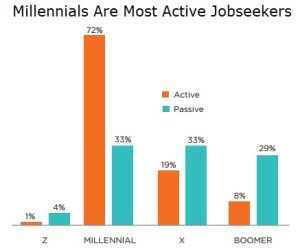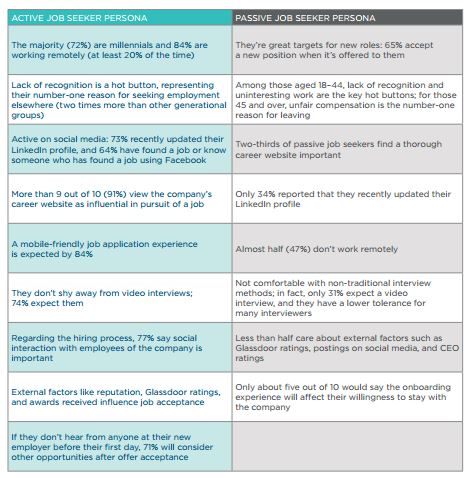In this red-hot talent market, savvy recruiters are employing consumer marketing strategies to attract and engage top candidates. As any marketer will tell you, it’s important to know your target audience to craft the right strategy.
Based on my company’s survey of active and passive job sectors, it’s clear there are significant differences between the two groups and differences, too, among the generations represented in each.
We at Engage2Excel surveyed 940 active and 507 passive job seekers to provide insight into the perceptions, preferences and behaviors of these two groups. Some of the results in our 2017 Trendicators™ Report may surprise you.
Recognition is important
Dr. Jack Wiley, our chief scientific officer, has researched engagement for more than 30 years. According to the research, the most effective engagement efforts are well integrated across the entire employment lifecycle – and they start before a candidate is hired. Strong programs address what employees want most: recognition, exciting work, security, pay, education and career growth, conditions and truth and respect.
We all like recognition, but it seems particularly important to millennials, the largest generation in U.S. workforce today. Some 81% of millennials rate recognition during the pre-hire stage as Very Important or Important. Other generations rate it as less important, but important enough to pay attention (55% for Gen X, 39% for Boomers and 31% for Gen Z).
Incorporating this knowledge into the candidate pre-hire experience is easy to do. For example, you might tell a candidate that you are impressed by specific accomplishments on their résumé, or highlight the way they have articulated a special project or answer to an interview question.
Active job seekers: Fertile ground for engagement
 By far, active job seekers are millennials; they accounted for 72% of the self-described “active job seeker” in our survey. As the first generation of digital natives, it’s not much of a surprise they expect a mobile-friendly experience (84%) and believe that social interaction with employees is important (77%) in the hiring process. Nearly three-quarters (73%) of active job seekers have recently updated their LinkedIn profile.
By far, active job seekers are millennials; they accounted for 72% of the self-described “active job seeker” in our survey. As the first generation of digital natives, it’s not much of a surprise they expect a mobile-friendly experience (84%) and believe that social interaction with employees is important (77%) in the hiring process. Nearly three-quarters (73%) of active job seekers have recently updated their LinkedIn profile.
This group is ready to engage.
At minimum you should ensure your employment brand accurately reflects your company’s unique culture and employment value proposition. If you’re up for taking it to the next level – and differentiating yourself from the competition – create scenarios that allow candidates to engage socially with employees before or during the hiring process, such as mixers, sporting events or open houses with people from relevant departments.
Passive candidates most likely to say “yes”
Surprisingly, only 26% of active job seekers report accepting an offer in their most recent recruitment experience; 65% of passive candidates did. The passive group, however, is much less concerned about employer ratings, such as those on Glassdoor. That isn’t to say they are unimportant, just that fewer than half the passive candidates give ratings and social media postings as much weight.
It may take more work to track down the passive candidates, but the ROI may well be worth it. And once an offer is accepted, keep up the high touch.

Pre-boarding and onboarding are important
Onboarding is a key factor in retaining the talent you just hired. As we note in the report, “More than half of respondents consider the onboarding experience crucial. If the experience is poor, they’ll seek employment elsewhere. And if the experience is a positive one, they’re more likely to stay.”
Here are some findings:
- Once they’ve accepted a job 71% of active candidates said they’d consider other opportunities if they don’t hear from their new employer before their first day.
- Half the passive job seekers said their onboarding experience would impact their willingness to stay with their new employer.
Both active and passive candidates told us:
- 69% say that their first day on the job experience will affect their decision to stay with the organization for more than a month.
- 72% say that their total onboarding experience will affect their decision to stay with the organization for more than a year.
- 59% say that a poor onboarding experience will result in their immediately looking for a job outside of the company.
You already know the talent acquisition space is evolving; in addition to increased competition, change is evident in candidate values and priorities, and even in the structure of work itself. In order to attract and engage the best candidates, we all need to ensure our recruiting strategies keep pace.
